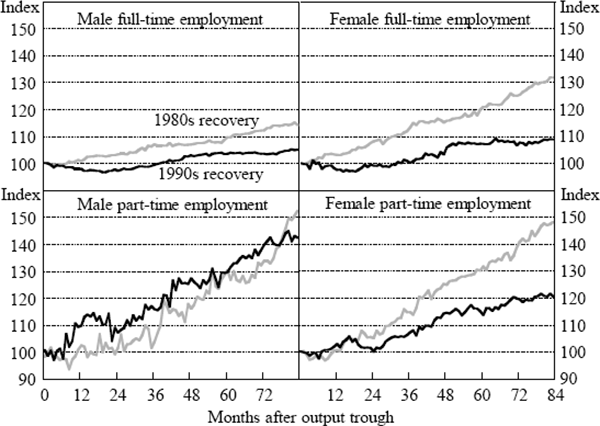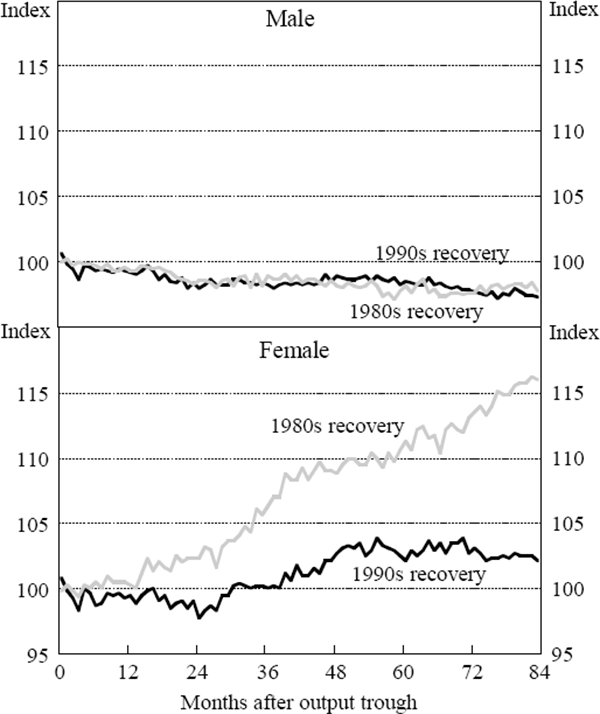RDP 9804: Stylised Facts of the Australian Labour Market 3. A Comparison of the Labour Market in the 1980s and 1990s Recoveries
April 1998
- Download the Paper 485KB
In this section we compare the performance of the labour market as the economy has recovered from the two most recent recessions of 1982–83 and 1991. We date the recoveries using output rather than any labour market variable. Thus the two recoveries are assumed to commence in the first quarter of 1983 and the second quarter of 1991 respectively. While the 1980s recovery lasted just over 7 years, the 1990s recovery is still ongoing. On the basis of trends in unemployment, the recovery dates would be somewhat later.
Output growth was stronger in the 1980s recovery than in the 1990s, at 4.6 per cent per annum compared to 3.7 per cent per annum. The 1980s recession was also somewhat sharper than that in the 1990s, with growth rates recovering more quickly. Thus some of the differences in labour market outcomes reflect differences in the relative strength and shape of the two recoveries. In particular, the unemployment rate in the 1990s recovery continued to rise through the first 18 months of the recovery in output and did not start to fall until 30 months into the recovery.
As can be seen from Figure 14, the unemployment rate had fallen to the same rate of around 8.5 per cent about four years into both recoveries. However, subsequently the unemployment rate has remained flat in the 1990s recovery whereas it trended down in the 1980s recovery. It is also noteworthy that in the 1980s recovery, unemployment was flat at just over 8 per cent, or even rose slightly, from month 30 through to month 50 before trending downward. This period of flatness in the labour market appears to have occurred at a later stage in the 1990s recovery (although not if the recovery is dated on the basis of the trend in unemployment) and has already run for a longer period (now over 30 months).

In the rest of this section, we decompose these two unemployment outcomes to ascertain what developments in the labour market account for the differences. First we break the unemployment rate into its components: male and female, full-time and part-time. Secondly, we compare the employment growth experience and movements in the participation rate, both of which contribute to the trends in the unemployment rate. Finally, we compare the employment growth by industry.
3.1 Unemployment Rates
Figure 15 shows the trends in the male and female unemployment rates over the two recoveries. Male unemployment in the 1990s recovery has been consistently higher than in the 1980s recovery whereas female unemployment has been approximately similar with the exception of the most recent 12 to 18 months. Male unemployment in the 1990s recovery continued to rise for over a year after the turnaround in output whereas in the 1980s recovery it continued to rise for only 6 months (in part, reflecting the differing strengths of the recovery in output). As with the aggregate unemployment rate, the male unemployment rate in the 1990s recovery has not resumed a downward trend after flattening out, unlike the experience in the 1980s recovery. The female unemployment rate has only diverged over the past year or so, remaining flat in the 1990s recovery but trending down in the 1980s recovery.

Thus the difference in unemployment rates across the two recoveries primarily reflects differences in the unemployment rate for males (and particularly for full-time males). Changes in the unemployment rate are the net result of changes in employment growth and the participation rate. Consequently we now turn to a comparison of the developments in those labour market variables between the two recoveries.
3.2 Employment Growth and Participation Rates
Figure 16 shows the employment trends of the four major components of the labour force: female and male full-time and part-time employment. All groups have experienced considerably weaker employment growth in the 1990s recovery compared to the 1980s recovery with the notable exception of male part-time employment. Male part-timers comprise the smallest portion of the employed labour force however, and therefore only contributed slightly to total employment growth. Full-time employment growth in the 1990s recovery has been considerably slower than that in the 1980s recovery, growing by 4.8 per cent in the first six years of the 1990s recovery compared to 16.8 per cent in the first six years of the 1980s recovery. Table 4 summarises this information by presenting the total employment growth over the first six years of both recoveries, and the contribution of each labour market group to the total change.[11] Again, it is particularly evident that the slow growth in employment for full-time males primarily accounts for the slower overall employment growth in the 1990s recovery. Growth in full-time employment for females has also been significantly slower.

| Employment growth (per cent over 6 years) |
Contribution to total employment
growth (per cent) |
|||
|---|---|---|---|---|
| 1980s recovery | 1990s recovery | 1980s recovery | 1990s recovery | |
| Male full-time | 12.9 | 3.6 | 7.6 | 1.9 |
| Male part-time | 33.6 | 41.2 | 1.3 | 2.2 |
| Male | 14.2 | 7.0 | 8.9 | 4.1 |
| Female full-time | 26.5 | 7.4 | 6.3 | 1.9 |
| Female part-time | 41.3 | 19.2 | 5.6 | 3.3 |
| Female | 31.9 | 12.2 | 11.9 | 5.1 |
| Full-time | 16.8 | 4.8 | 13.8 | 3.7 |
| Part-time | 39.6 | 24.4 | 7.0 | 5.5 |
| Total | 20.8 | 9.2 | 20.8 | 9.2 |
Notes: Employment growth is measured from the start of the recovery (first quarter of 1983 and second quarter of 1991 respectively) through to the end of the sixth year of the recovery. Contributions to growth are measured using the initial employment shares. |
||||
The male participation rate has exhibited a similar downward trend over both recoveries (Figure 17). The level of the male participation rate (and the employment to population ratio) is lower in the 1990s recovery, which may be indicative of a larger discouraged worker effect. On the other hand, the female participation rate has been relatively flat since 1991, whereas in the 1980s recovery it rose steadily.

In summary, the similar trend in female unemployment in the two recoveries (until the most recent twelve months) masks the fact that in the 1980s strong employment growth was accompanied by a large rise in the participation rate, whereas in the 1990s recovery both employment growth and the rise in the participation rate were less. As Borland (1997a) notes, if the participation rate for females had grown at the same rate in the 1990s as it did in the 1980s, all other things equal, the aggregate unemployment would have been nearly three percentage points higher. In contrast, the difference in male unemployment between the two recoveries is solely accounted for by slower employment growth, particularly full-time employment growth, in the 1990s recovery, as the participation rate trends have been very similar.
3.3 Employment Growth by Industry
Breaking down employment growth by industry, we find that every industry has experienced weaker employment growth in the 1990s recovery than in the 1980s recovery (Table 5). Furthermore, employment in the finance and insurance sector, which was a strong source of employment growth in the 1980s recovery (particularly for females), averaging 6.6 per cent annual growth over the six years from 1983 to 1989, has in fact fallen in the 1990s recovery. Employment in the retail and wholesale trade industries (again, relatively large employers of females), which in September 1997 accounted for around 20 per cent of aggregate employment, has also been considerably weaker in the 1990s. Employment in those two sectors grew by an average annual rate of 5.3 per cent in the first six years of the 1980s recovery but only by 1.3 per cent in the 1990s recovery.
| Industry | Employment share June 1997 (per cent) |
Average annual employment growth 1980s recovery (per cent) |
Average annual employment growth 1990s recovery (per cent) |
|---|---|---|---|
| Retail trade | 14.6 | 5.5 | 2.0 |
| Manufacturing | 13.6 | 0.8 | 0.5 |
| Property | 10.0 | 7.4 | 5.3 |
| Health and community services | 9.2 | 4.6 | 1.8 |
| Education | 6.9 | 3.1 | 1.7 |
| Construction | 6.9 | 5.6 | 0.9 |
| Wholesale trade | 5.9 | 4.9 | −0.3 |
| Agriculture | 5.2 | 0.7 | 0.3 |
| Accommodation/cafes | 4.9 | 5.3 | 3.5 |
| Transport | 4.7 | 0.5 | 0.2 |
| Govt admin | 4.3 | 1.3 | 0.4 |
| Personal services | 4.0 | 3.7 | 3.4 |
| Finance | 3.7 | 6.6 | −1.8 |
| Recreational services | 2.4 | 5.4 | 4.5 |
| Communication | 1.9 | 1.8 | 1.7 |
| Mining | 1.0 | −0.3 | −1.6 |
| Utilities | 0.8 | −2.5 | −6.2 |
| Total | 100.0 | 3.4 | 1.4 |
Note: Average annual growth rates, calculated from March quarter 1983 to the March quarter 1989 and June quarter 1991 to June quarter 1997, respectively. |
|||
Other sectors that have experienced significantly weaker employment growth in the 1990s recovery include construction, electricity, gas and water, accommodation and cafes, property, education, and public administration and defence. Mining and primary-sector employment have been generally volatile in both recoveries.
Footnote
The contributions are weighted by the initial employment share. [11]